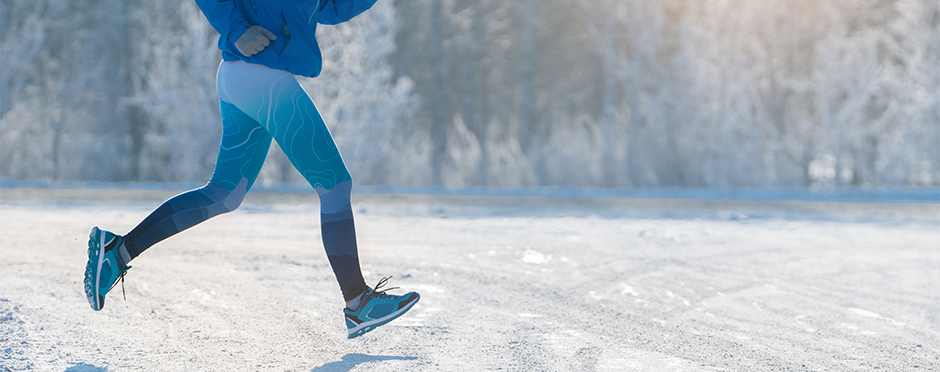
Winter Workouts: Cold Weather Considerations
Leave a CommentWinter is here and the weather is cold and snowy, but your workouts do not have to stop. Cold weather athletes participate in events that include skiing, cold weather running and triathlons.
Similar to hot climates, exercising during cold temperatures comes with risks, including cold weather injuries. Before heading outdoors for your workout this winter, read below to learn about risk factors and prevention tips for these types of injuries.
What Happens to Your Body in the Cold
The body’s first response to cold is to preserve the core body temperature. This is done via peripheral vasoconstriction of the blood vessels, which means the body decreases the blood flow to the arms and legs. This is effective for short durations of time. If exposure continues, the athlete can lose muscle coordination, performance decreases and the risk for freezing injuries grows. The body also tries to generate heat via involuntary shivering or other behavior modifications to increase physical activity. If the core temperature drops further, the shivering response declines and the risk of frostbite rises.2
Risk Factors for Cold Injury2
• Weather: cold, wet and windy conditions are most likely to predispose a freezing injury
• Poor clothing choices
• Underlying medical conditions such as hypoglycemia and low caloric intake
• Skin conditions including burns or sunburns
• Cold water immersion
• Prior cold injury
• Lower muscle mass and lower percent body fat individuals have a more difficult time maintaining their core temperature
Types of Cold Injuries
Frostnip: Frostnip is a superficial nonfreezing injury of exposed skin. Skin may feel numb, and appear pale or pink. Ice crystals may also appear on the skin surface. These symptoms resolve with skin covering, or behavior modification with no long term damage.2
Behavior modifications to prevent frostnip include:
• Covering hands, head, neck, ears and nose
• Monitoring skin that is exposed for change in color or to see if ice crystals are forming
• Keeping your body moving if you are out in the cold for long periods of time
• Not spending long periods of time outdoors in very cold temperatures
Frostbite: Frostbite is a direct freezing injury to outer tissues and occurs when skin temperature drops.2 It is more common to occur in areas of the body with less blood flow, such as the nose, ears, fingers, and toes because these are further from the body’s core. Contact frostbite can also occur when skin is exposed to a substance with a temperature below skin freezing temperature, such as metal, gasoline, ice packs or alcohol.2
The severity of frostbite is related to the temperature, duration of exposure, and amount and depth of frozen tissue.2 There are observable skin changes that occur prior to true frostbite and should be recognized to help protect an athlete in the cold.
Hypothermia: Hypothermia is defined as a decrease in core body temperature below 35 degrees Celsius. It can be classified as mild, moderate or severe depending on the measured core temperature. Signs and symptoms of hypothermia include vigorous shivering, increased blood pressure, fine motor skill impairment, fatigue, apathy and mild amnesia.1
Prevention of Cold Injury2
• Proper layering of clothing. Your innermost layer of clothing should wick moisture away from the body
• Wearing hats can decrease heat loss from the head.
• Use mittens to protect hands as they help prevent frostbite better than gloves.4
• Clothing and layering should not be too tight, as this can also restrict blood flow (ex: if you need to wear more than one pair of socks you should also go up one shoe size).
• Keep core and areas with a large potential for heat loss covered (head, neck, armpits).
• Be prepared to adjust your clothing accordingly with changing weather conditions, such as a sudden decrease in temperature.
• Avoid alcohol and caffeine as they increase vasoconstriction.
• Make sure you have adequate caloric intake (ex: frequent snacks).
• Perform frequent cold checks to recognize any changes in skin or behavior, especially if the buddy system can be applied.
• Monitor the temperature. Many outdoor sports and events have a set temperature required for the event to occur to decrease cold weather-related risks.
Working Out All Year Long
By following these guidelines, you can maintain your outdoor workout routine all year long. As always, if you experience any aches and pains after exercising, make sure to schedule a free assessment at your nearest Athletico location.
Free assessments are available in-clinic and virtually through our telehealth platform.
The Athletico blog is an educational resource written by Athletico employees. Athletico bloggers are licensed professionals who abide by the code of ethics outlined by their respective professional associations. The content published in blog posts represents the opinion of the individual author based on their expertise and experience. The content provided in this blog is for informational purposes only, does not constitute medical advice and should not be relied on for making personal health decisions.
References:
1. Cappaert TA, Stone JA, Castellani JW, Krause BA, Smith D, Stephens BA. National Athletic Trainers’ Association Position Statement: Environmental Cold Injuries. Journal of Athletic Training. 2008;43(6):640-658.
2. Fudge J. Exercise in the Cold: Preventing and Managing Hypothermia and Frostbite Injury. Sports Health. 2016;8(2):133-139.
3. Smith M, Matheson GO, Meeuwisse WH. Injuries in cross-country skiing: a critical appraisal of the literature. Sports Med. 1996;21:239-250.
4. Haririchi I, Arvin A, Vash JH, Zafarmand V. Frostbite: incidence and predisposing factors in mountaineers. Br J Sports Med. 2005;39:898-901
